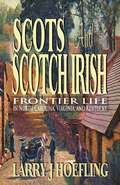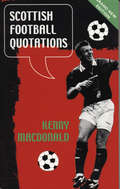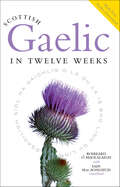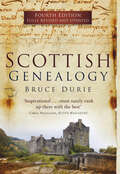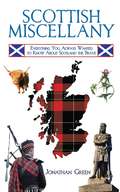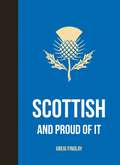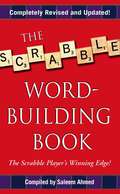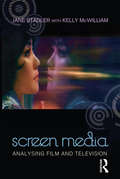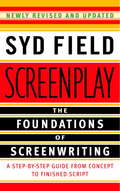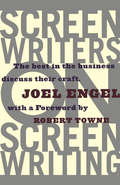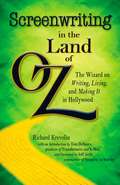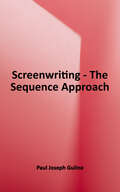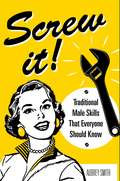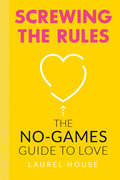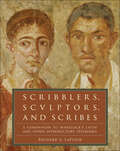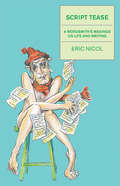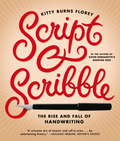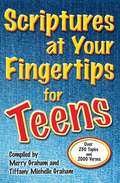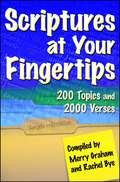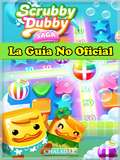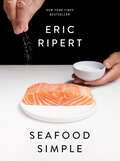- Table View
- List View
Scots and Scotch Irish: Frontier Life in North Carolina, Virginia, and Kentucky
by Larry J. Hoeflingfrom the book's back cover: "They left Ireland by the boatload to head for America before the Revolution, and settled on the rugged western frontiers of the colonies. The descendants of Scotsman who had settled in the Irish Kingdom of Ulster, they lived for several generations on Irish soil before heading across the Atlantic and the backwoods of America. They founded communities in the Shenandoah Valley of Virginia and the Yadkin River Valley of western North Carolina, eventually crossing the Cumberland Gap and settling the Kentucky frontier. For those Scots-Irish immigrants, life was a test of hardiness, hardship, and endurance, but frontier families also managed time for horseracing, gambling, and socializing - despite their strict Presbyterian ways. They founded churches and helped mold the governments of the new country. Scots and Scotch Irish offers a view of that time and place, along with thousands of names of those early settlers, drawn from church records, military rolls, deeds, court records, and newspapers of the time, all listed alphabetically in a series of appendices by source. A former newspaper reporter and Radio/TV Broadcaster, Larry Hoefling received national journalism awards from Columbia University in NYC and the Scripps-Howard Media Foundation. After spending years as the co-owner of an Irish pub in Tulsa, OK, he currently works as a bookseller and freelance writer in Broken Arrow, OK."
Scottish Football Quotations
by Kenny MacdonaldIn this, the follow-up to the critically acclaimed first volume of quotations about our national sport, Kenny MacDonald delves once more into Scotland's sweaty, smelly football dressing-rooms and emerges with a batch of statements which are profond, amusing, acerbic and sometimes plain bizarre.
Scottish Gaelic in Twelve Weeks: With Audio Download
by Iain MacAonghuis Roibeard O'MaolalaighThis new 2023 edition includes an audio download link. Scottish Gaelic in Twelve Weeks has been written both as a self-tuition course for beginners and also for use within the classroom. You may want to learn Gaelic because of a general interest in Celtic or Scottish history and culture, or because it was the everyday language of your ancestors. The cynical observer may wonder if the exercise is worthwhile, when only 1.5 per cent of Scotland’s population speak the language. However, Gaelic is far from dead; in some parts of the Highlands and Western Isles it is the everyday language and it represents an important part of the United Kingdom’s cultural mix. There are Gaelic-learning classes in almost every area of Scotland. Each lesson in the book contains some essential points of grammar explained and illustrated, exercises, a list of new vocabulary (with a guide to pronunciation, using the International Phonetics Alphabet), and an item of conversation.
Scottish Genealogy (Fourth Edition)
by Bruce DurieThis fully revised and updated fourth edition of Scottish Genealogy is a comprehensive guide to tracing your family history in Scotland. Written by one of the most authoritative figures on the subject, the work is based on established genealogical practice and is designed to exploit the rich resources that Scotland has to offer. After all, this country has possibly the most complete and best-kept set of records and other documents in the world. Addressing the questions of DNA, palaeography and the vexed issues of clans, families and tartans, and with a new chapter on DNA and genetic genealogy, Bruce Durie presents a fascinating insight into discovering Scottish ancestors. He covers both physical and electronic sources, explains how to get beyond the standard ‘births, marriages and deaths plus census’ research, and reminds the reader that there are more tools than just the internet. Comparisons are made with records in England, Ireland and elsewhere, and all of the 28 million people who claim Scottish ancestry worldwide will find something in this book to challenge and stimulate. Informative and entertaining, this new edition is the definitive reader-friendly guide to genealogy and family history in Scotland.
Scottish Miscellany: Everything You Always Wanted to Know About Scotland the Brave (Books of Miscellany)
by Jonathan GreenWith Scottish Miscellany, author Jonathan Green lets you revel in the fun and fascinating explanations behind Scottish traditions and folklore, giving you the answers to questions you've always had--or never knew you had--and more as he covers all aspects of Scotland. From Scottish culture to the ancient history of the country to modern pastimes, this book has all that and more. Learn why the thistle is the floral emblem of Scotland, how Scotch whisky is made, why the Scots celebrate Hogmanay, how to play the bagpipes, and much more. This delightful book is the perfect gift for anyone planning a visit to Scotland, with an interest in Scottish history, or a drop of Scottish blood.
Scottish and Proud of It
by Greig FindlayScotland is loved for its sublime mountain ranges, its breathtaking castles and for being the birthplace of legendary cultural figures such as Sir Walter Scott and Sean Connery. Celebrate your roots and explore some of Scotland's most fascinating facts and charming quotes in this miscellany fit for any bonnie lad or lass.
Scottish and Proud of It
by Greig FindlayScotland is loved for its sublime mountain ranges, its breathtaking castles and for being the birthplace of legendary cultural figures such as Sir Walter Scott and Sean Connery. Celebrate your roots and explore some of Scotland's most fascinating facts and charming quotes in this miscellany fit for any bonnie lad or lass.
Scrabble Word-Building Book
by Saleem AhmedWant to outsmart, outwit, and outplay your Scrabble® opponents? Using the completely revised and updated The Scrabble® Word-Building Book, you can! This essential strategy guide shows you how to build on your opponents' words and become a master of this classic game. For novice players and expert wordsmiths alike, this helpful reference includes: A handy list of the 94 two-letter words sure to pile on the points Over 800 three-letter words -- 550 of which can be formed from two-letter words All eight-letter words that can be formed from seven-letter words Every word up to seven letters you can play! To increase your word-building power and achieve the highest score, keep The Scrabble® Word-Building Book at your fingertips -- and beat your opponent every time!
Screen Media: Analysing Film and Television
by Jane Stadler Kelly McWilliamScreen Media offers screen enthusiasts the analytical and theoretical vocabulary required to articulate responses to film and television. The authors emphasise the importance of 'thinking on both sides of the screen'. They show how to develop the skills to understand and analyse how and why a screen text was shot, scored, and edited in a particular way, and then to consider what impact those production choices might have on the audience.Stadler and McWilliam set production techniques and approaches to screen analysis in historical context. They demystify technological developments and explain the implications of increasing convergence of film and television technologies. They also discuss aesthetics, narrative, realism, genre, celebrity, cult media and global screen culture. Throughout they highlight the links between screen theory and creative practice.With extensive international examples, Screen Media is an ideal introduction to critical engagement with film and television.'Screen Media offers a systematic approach to film and television analysis. The examples chosen by the authors are both appropriate and timely, and are presented in a very lively and readable form that will appeal to an international readership.' - Rebecca L. Abbott, Professor of Film, Video + Interactive Media, Quinnipiac University, USA
Screenplay, Revised Edition: The Foundations of Screenwriting
by Syd FieldA generation of screenwriters has used Syd Field's bestselling books to ignite successful careers in film. Now the celebrated producer, lecturer, teacher, and bestselling author has updated his classic guide for a new generation of filmmakers, offering a fresh insider's perspective on the film industry today. From concept to character, from opening scene to finished script, here are easily understood guidelines to help aspiring screenwriters--from novices to practiced writers--hone their craft. <P><P> Filled with updated material--including all-new personal anecdotes and insights, guidelines on marketing and collaboration, plus analyses of recent films, from American Beauty to Lord of the Rings--Screenplay presents a step-by-step, comprehensive technique for writing the screenplay that will succeed in Hollywood. Discover: <P> * Why the first ten pages of your script are crucially important <P> * How to visually "grab" the reader from page one, word one <P> * Why structure and character are the essential foundation of your screenplay <P> * How to adapt a novel, a play, or an article into a screenplay <P> * Tips on protecting your work--three legal ways to claim ownership of your screenplay <P> * The essentials of writing great dialogue, creating character, building a story line, overcoming writer's block, getting an agent, and much more. <P> With this newly updated edition of his bestselling classic, Syd Field proves yet again why he is revered as the master of the screenplay--and why his celebrated guide has become the industry's gold standard for successful screenwriting.
Screenwriters on Screen-Writing: The Best in the Business Discuss Their Craft
by Joel EngelBefore any lights, camera, or action, there's the script--arguably the most important single element in filmmaking, and Screenwriters on Screen-Writing introduces the men and women responsible for the screenplays that have produced some of the most successful and acclaimed films in Hollywood history. In each interview, not only do the writers explore the craft and technique of creating a filmic blueprint, but they recount the colorful tales of coming up in the ranks of the movie business and of bringing their stories to the screen, in a way that only natural-born storytellers such as themselves can. These and other screenwriters have garnered the attention of the movie-going population not only with their words, but with headlines announcing the sales of their scripts for hundreds of thousands and sometimes millions of dollars.Anyone interested in writing, making, or learning about movies will enjoy reading this fascinating behind-the-scenes compendium that brings together some of the most prominent and talented screenwriters in modern-day filmmaking. Screenwriters interviewed include:Bruce Joel Rubin (Ghost), Ernest Lehman (North by Northwest, Who's Afraid of Virginia Woolf?), Amy Holden Jones (Indecent Proposal), Ted Tally (The Silence of the Lambs), Horton Foote (To Kill a Mockingbird, Tender Mercies), Andrew Bergman (The In-Laws), Caroline Thompson (Edward Scissorhands), Richard LaGravenese (The Fisher King), and Robert Towne (Chinatown, Shampoo).
Screenwriting in The Land of Oz
by Richard KrevolinSet your sights on a screenwriting career--and you know you're not in Kansas anymore. With some 100,000 original screenplays vying to be among the 7,000 few made into movies every year, craft is key and competition is fierce. Enter the Wizard: Award-winning screenwriter and playwright and acclaimed writing instructor Richard Krevolin, who shows you the way to turn your good ideas into great stories, and your great stories into compelling scripts.With the writer's gift for storytelling and the professor's gift for teaching, Krevolin gives you the brains, heart, and courage you need to make it in the Emerald City of Hollywood--one yellow brick at a time.
Screenwriting in The Land of Oz: The Wizard on Writing, Living, and Making It In Hollywood
by Richard KrevolinSet your sights on a screenwriting career-and you know you're not in Kansas anymore. With some 100,000 original screenplays vying to be among the 7,000 few made into movies every year, craft is key and competition is fierce. Enter the Wizard: Award-winning screenwriter and playwright and acclaimed writing instructor Richard Krevolin, who shows you the way to turn your good ideas into great stories, and your great stories into compelling scripts.With the writer's gift for storytelling and the professor's gift for teaching, Krevolin gives you the brains, heart, and courage you need to make it in the Emerald City of Hollywood-one yellow brick at a time.
Screenwriting in the Land of Oz
by Richard KrevolinSet your sights on a screenwriting career--and you know you're not in Kansas anymore. With some 100,000 new, original screenplays vying to be among the 7,000 few made into movies every year, craft is key and competition is fierce. Enter the Wizard: Award-winning screenwriter, playwright, and acclaimed writing instructor Richard Krevolin, who shows you the way to turn your good ideas into great stories, and your great stories into compelling scripts. With the writer's gift for storytelling and the professor's gift for teaching, Krevolin gives you the brains, heart, and courage you need to make it in the Emerald City of Hollywood--one yellow brick at a time.
Screenwriting: The Sequence Approach
by Paul Joseph GulinoThe great challenge in writing a feature-length screenplay is sustaining audience involvement from pages one through 120. This book expounds on an often-overlooked tool that can be key in solving this problem. A screenplay can be understood as being built of sequences of about fifteen pages each, and by focusing on solving the dramatic aspects of each of these sequences in detail, a writer can more easily conquer the challenges posed by the script as a whole. <p><p>The sequence approach has its foundation in early Hollywood cinema (until the 1950s, most screenplays were formatted with sequences explicitly identified), and has been rediscovered and used effectively at such film schools as the University of Southern California, Columbia University and Chapman University. This book exposes a wide audience to the approach for the first time, introducing the concept and then providing a sequence analysis of eleven significant feature films made between 1940 and 2000.
Screw It!: Traditional Male Skills That Everyone Should Know
by SmithHave you ever wondered how you’d survive without a man to attend to the odd jobs around the house? Have you ever wished you knew how to put up a shelf or check the oil in your car? And, more importantly, not have to call a man around to help? Then this is the book for you! From changing a car tire and checking brake fluid and coolant to building a campfire, Screw It! features traditionally male skills to help you learn invaluable information. Divided into sections focusing on vehicle maintenance, the home, the garden, and the great outdoors, each task is concisely explained and accompanied by beautifully illustrated instructions. Never again will you need to rely on men! This essential guide will help you become a completely self-sufficient and independent woman in today’s world.
Screwing the Rules: The No-Games Guide to Love
by Laurel HouseDating isn’t about games; it’s about strategy. What’s the difference? Games are for fun and manipulation. Strategy is about dating smart and on-purpose. Screwing the Rules will challenge you to examine your expectations, hopes and dreams, dating strategy, relationship goals--and yourself--so that you can find "the” one, as opposed to just another "some” one. Screwing the Rules will take you full circle, from working on yourself and figuring out what you need in a guy, to how to find him, get him, and keep him (or cut him loose and get over him if you need to). Get ready to become your best, most confident, powerfully feminine self through no-games insight, tools, and actionable advice that will finally put you on the right path to find your ideal match.
Scribal Correction and Literary Craft
by Daniel WakelinThis extensive survey of scribal correction in English manuscripts explores what correcting reveals about attitudes to books, language and literature in late medieval England. Daniel Wakelin surveys a range of manuscripts and genres, but focuses especially on poems by Chaucer, Hoccleve and Lydgate, and on prose works such as chronicles, religious instruction and practical lore. His materials are the variants and corrections found in manuscripts, phenomena usually studied only by editors or palaeographers, but his method is the close reading and interpretation typical of literary criticism. From the corrections emerge often overlooked aspects of English literary thinking in the late Middle Ages: scribes, readers and authors seek, though often fail to achieve, invariant copying, orderly spelling, precise diction, regular verse and textual completeness. Correcting reveals their impressive attention to scribal and literary craft – its rigour, subtlety, formalism and imaginativeness – in an age with little other literary criticism in English.
Scribblers, Sculptors, and Scribes: A Companion to Wheelock's Latin and Other Introductory Textbooks
by Richard A. LaFleurAn outstanding and enjoyable companion reader to the Wheelock’s curriculum, or any introductory Latin textbook.From one of the country’s leading Latinists, this reader is the perfect complement to any Latin program, and the first collection of entirely authentic classical Latin texts that beginning students, from the very first day of their introduction to Latin, can read and enjoy.Beginning with simple graffiti, Scribblers, Sculptors, and Scribes moves toward longer inscriptions and literary texts as students progress. Designed to accompany the bestselling Wheelock’s curriculum, its 40 chapters are linked with the 40 chapters of Wheelock’s Latin, but the book’s readings and design features make it suitable for use alongside any introductory college or high-school Latin textbook. Packed with hundreds of actual Latin inscriptions, proverbs, and texts, this outstanding textbook also includes dozens of photos and illustrations, maps, discussion and comprehension questions, grammar capsules, a Latin–English vocabulary section, a summary of forms, and much more.
Script Tease: A Wordsmith's Waxings on Life and Writing
by Eric NicolWhy write in the first place, other than your grocery list? Eric Nicol believes it’s the second-most satisfying thing you can do lying down. But it’s not enough to want to write. You must need to write. Now, after more than seventy years of scribbling – he wrote for the school newspaper at Lord Byng High School in Vancouver, British Columbia – Eric holds forth on dangling participles, punctuation, and literary jargon. What’s more, he answers the burning question: "How much should creative writers depend on editors to correct their grammar?" Then Eric provides a wide selection of essays to demonstrate how it’s done. These include a dramatic demonstration of the chutzpah of a big Tom wild turkey and its harem on a B.C. Gulf Island, the discovery that Eric’s one-way-view window in the bathroom has been installed incorrectly, the trials and tribulations of computers and the creative process, and a riposte to the query, "Are nipples really necessary on guys?" Pure Nicol. Minted in Canada. Priceless!
Script and Scribble
by Kitty Burns Florey"A witty and readable (and fetchingly illustrated and glossed) excursion through the history of handwriting." --The Wall Street JournalLet a self-confessed "penmanship nut" take you on a tour of the strange and beautiful world of handwriting. Since her Catholic school days learning the Palmer Method, Kitty Burns Florey has been in love with handwriting, and can't imagine a world where schools forego handwriting drills in favor of teaching something called keyboarding. In this "winsome mix of memoir and call to arms" (Chicago Tribune), Florey weaves together the evolution of writing implements and scripts, pen-collecting societies, the golden age of American penmanship, and the growth in popularity of handwriting analysis, and asks the question: Is writing by hand really no longer necessary in today's busy world? "Charmingly composed and handsomely presented," Script & Scribble traces the history of penmanship to the importance of writing by hand in an increasingly digital age (The Boston Globe). From the Trade Paperback edition.
Scriptures at Your Fingertips for Teens
by Merry Graham Tiffany Michelle GrahamThis handy, alphabetically organized, quick-find Bible reference gives teens immediate access to what Scripture says on topics such as angels, addiction, goals, gangs, work, and weapons. The ancient wisdom of the Bible is as relevant to today's life issues as the day it was written. Scriptures at Your Fingertips for Teens is an extensive, easy-to-use reference for busy teens who want quick answers from God's Word for the problems and moral complexities they face on a daily basis. Concerned parents and grandparents can take heart knowing this book is a trusted resource for their teens. In seconds, teens can know what the Bible says about peer pressure, suicide, confidence, and even magic. Containing more than 2,000 verses, this book makes a great gift for any gift-giving occasion: graduation, birthdays, Christmas, Easter, or just to say "I'm thinking of you." Compiled by a mother and daughter team, every word of this book comes straight from the Bible, with no added commentary. This reference will enrich the lives of teen readers and provide godly guidance and wisdom for any issues they face in these trying, formative years.
Scriptures at Your Fingertips: With Over 200 Topics and 2000 Verses
by Merry Graham Rachel ByeA topical guide to the Bible comprised of more than 2,000 verses from several popular Bible version with bold headings for quick identification, this book is an excellent source for teachers, writers, pastors, and anyone who loves the Scriptures. A topical guide to the Bible that's as easy to use as a dictionary! Are you struggling with grief? Searching for God's comforting mercy and grace? Trying to learn how to raise your children in the Lord's way? Wouldn't you like to have the most significant verses from the Bible on those topics right at your fingertips? Well, now you do! Compiled by Merry Graham and Rachel Bye, international leaders of A Passion to Pray ministry, Scriptures at Your Fingertips is a handy, quick-reference guide that immediately offers what God's Word says on more than 200 important prayer topics. And because the topics are arranged in alphabetical order, they're so easy to find. Perfect for beginning Bible students or for seasoned prayer warriors, this book is a must-have for people on the go or those who want to get more out of their prayer lives. Maximize your prayer time, and minimize your research time by having the Scriptures at your fingertips!
Scrubby Dubby Saga La Guía No Oficial
by Hiddenstuff Entertainment Dafne Abad Romero*GUÍA NO OFICIAL* Guía de estrategias y consejos avanzados. Es la guía más entendible y detallada que podrás encontrar en línea. Con el éxito de cientos de otras guías y estrategias, escribí una guía profesional y avanzada para jugadores nuevos y veteranos.¡ Te dará estrategias específicas y consejos de cómo progresar en el juego, ganarle a tus oponentes, obtener más monedas y mucho más! - Estrategias y tips profesionales. - Trucos. - ¡Secretos, Consejos y Trucos usados por jugadores Profesionales! - Cómo conseguir miles de monedas. - ¡Y MUCHO MÁS! Nota: Este producto no está asociado, afiliado, avalado, certificado, o patrocinado por el dueño original de los Derechos de Autor.
Seafood Simple: A Cookbook
by Eric RipertThe definitive seafood guide from the three-Michelin-starred chef of Le Bernardin, featuring gorgeous photography and step-by-step techniques alongside 85 accessible recipes for preparing incredible fish at home.&“I hope that this book is a source of inspiration and education, encouraging you to cook with confidence and approach seafood with joy, and even love. The secret to Seafood Simple is to trust the process, and yourself.&”In its three decades at the top of New York City's restaurant scene, Le Bernardin has been celebrated as one of the finest seafood restaurants in the world and its iconic chef Eric Ripert as the expert in fish cookery. Now, in Seafood Simple, Ripert demystifies his signature cuisine, making delectable fish dishes achievable for home cooks of all skill levels—yet still with elegance and panache.Breaking down cooking techniques into their building blocks, along with images to illustrate each step in the process, Seafood Simple teaches readers how to master core skills, from poaching and deep frying to filleting a fish and shucking an oyster. These techniques are then applied to eighty-five straightforward, delicious recipes, many of which include substitutions for maximum ease. Dishes like Tuna Carpaccio, Crispy Fish Tacos, Shrimp Tempura, Miso Cod, and Spaghetti Vongole show us how to bring out the vibrant flavor and incredible versatility of seafood. Each recipe is accompanied by a gorgeous image by renowned photographer Nigel Parry, as well as step-by-step photos for each of the twenty techniques taught in the book.Stunning, delectable, and above all, actually doable, Seafood Simple is a master class from one of the world's greatest chefs, created especially for the home cook.
